Good Never Dies: Repurposing Your Best Social Content into Ads
by Jacob Baadsgaard • May 2, 2017
Every single online marketer has experienced that dreaded moment at least once: they’re slumped in front of their computer, fresh out of ideas. When you’re stumped, you don’t need to reinvent the wheel to come up with great new copy.
Sometimes, the best thing you can do is to look at the content that’s already working for you.
Repurposing high-performing organic social media content is almost always a great strategy. It lets you get the most out of every great idea possible, and get big results quickly.
Why Repurpose Social Content?
Repurposing social media content into ads will give you an enormous supply of great ideas. Since ads need to be changed up every so often so that users will keep responding to them, this is a huge advantage! After all, it can be really difficult to keep coming up with something new.
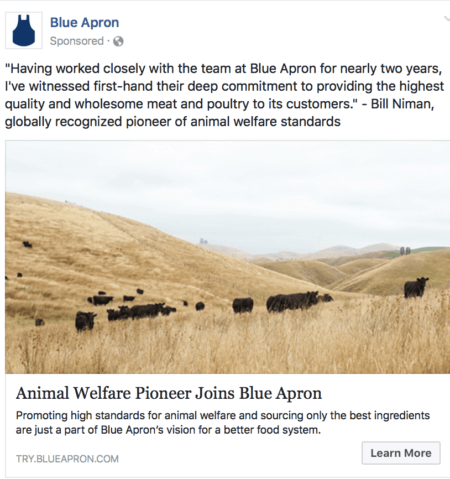
Great content—including quotes from influencers or blog posts—can become extremely effective as ad copy.
Quick content isn’t the only advantage of repurposing your social media content, though. As a general rule, if your social media following responds well to an organic post, your target audience will probably respond well to that same content in an ad, too.
With most new ad campaigns, you have to run split tests or interview your customers to create an effect ad. However, if you’re repurposing your own successful content, you already know that you’re addressing an important pain point. That kind of insight can save you a ton of time, headache and wasted ad spend.
How to Repurpose Social Media Content into Ads
There are a few steps you should always take when repurposing social media content into social media ads.
Step 1. Identify Top Content
The first step in repurposing your social media content is to identify your best performing content. Most social media platforms have native tools—like Facebook Insights or Pinterest Analytics—you can use to analyze post performance.
Alternatively, you can use social media scheduling and analytics tools like Sprout Social or Agorapulse to find your best performing content across a variety of social media platforms.
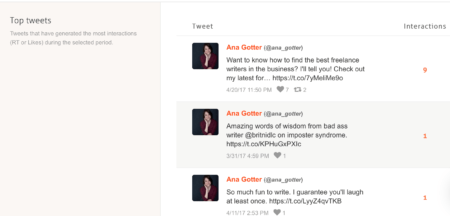
Social media analytics software like Agorapulse (pictured above) will help you identify your top content on all your social platforms quickly.
As you evaluate your posts, you’ll want to look at what specific results each post got. Some posts may have a ton of engagement, but not a lot of clicks, or vice-versa. Keep this in mind when choosing what you want your ads to accomplish—you wouldn’t want to try to drive conversions with posts that only got likes.
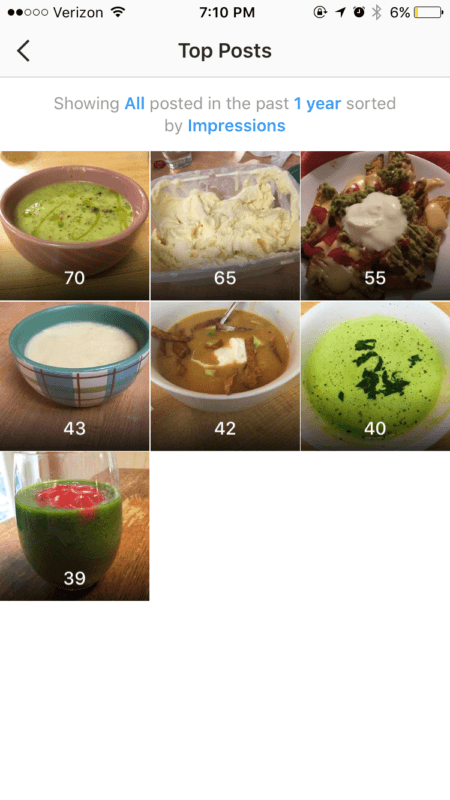
Instagram’s analytics shows you your top performing content, sorting it by impressions or engagement.
Keep in mind that just because a post performed well on Twitter, that doesn’t mean it won’t make a great Facebook Ad. As long as you are targeting the same basic audience, great content usually gets a great response on any social media platform.
Step 2. Choose Your Platform & Audience
Once you’ve found your top content, you have to decide how you want to use it. Who you want to target with your ad can have a big impact on which social media platform you use.
For example, Facebook has a wide and diverse audience, but other platforms like Pinterest or Snapchat may not. However, because their audiences are both more specific and often more responsive, Pinterest or Snapchat may produce much better results for certain types of ads.
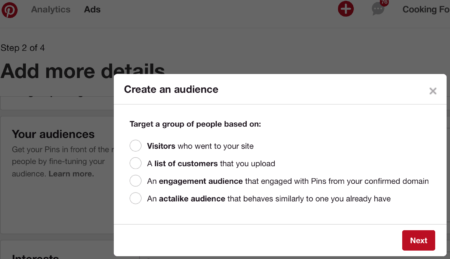
Different ad platforms have different targeting options.
The type of ad campaign and targeting strategy you decide to use can also have a big impact on which platform you choose to use.
For example, Facebook, Instagram, and LinkedIn all let you target by education and job title. Pinterest does not. Pinterest does have, however, better keyword targeting you can use to show up in users’ organic searches. Facebook, Instagram and LinkedIn don’t really have this option.
Although great content can work on a variety of social platforms, it’s important to keep the strengths and limitations of a new social media platform in mind before you repurpose your content for that platform.
Step 3. Adapt the Creative If Necessary
It might be tempting to copy-paste a successful organic post on Instagram into an ad campaign on Pinterest, but that would be a mistake. People expect different types of content on different social media platforms.
Sure, Instagram and Pinterest are both highly visual platforms, but their audiences have different expectations of their content. So, if you’re turning an Instagram post and turning it into a Pinterest ad, adjust the description and do away with the hashtags. You may also want to change the dimensions of the image to get better results on the platform.
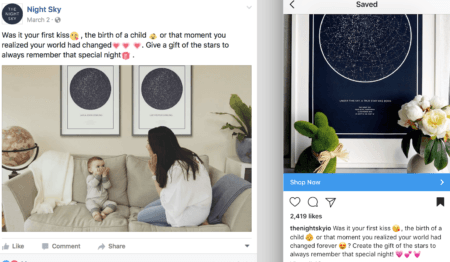
Night Sky used copy from an organic post on Facebook with a new image (ideal for that platform) on an Instagram Ad.
Don’t be afraid to tweak the copy of the post if necessary when creating an ad and tailor it to fit your specific campaign. Make sure it aligns with all the ad-specific features you can use, like Facebook and Instagram’s CTA buttons. You’ll also want to ensure that the text is enough to grab a cold audience.
Each ad campaign you run should be optimized for the specific platform you’re using, audience you’re targeting, and goal you want to accomplish. An ad focusing on the emotional appeal of your brand, possibly linking to content, would be great for brand recognition. On the other hand, one showcasing features and listing a sale would be ideal for conversions.
Is There Anything I Shouldn’t Repurpose?
There are really only a few types of content that you might not want to repurpose as social media ad campaigns.
The first is content that is time-sensitive. For example, at Disruptive, we sometimes share breaking industry news that gets a ton of engagement in the first 24 hours, and then isn’t quite as relevant anymore. This type of content, especially if it leads to a blog post or article of a developing story, can be too difficult to maintain as an ad campaign that has to be submitted, approved, and then distributed.
You also want to only promote content that can help you achieve specific goals, like brand awareness or conversions. For example, on Disruptive’s page, we share behind-the-scenes content or updates about our employees. These posts perform have great reach and engagement, but they aren’t good candidates for paid ads because they don’t really advertise our business.
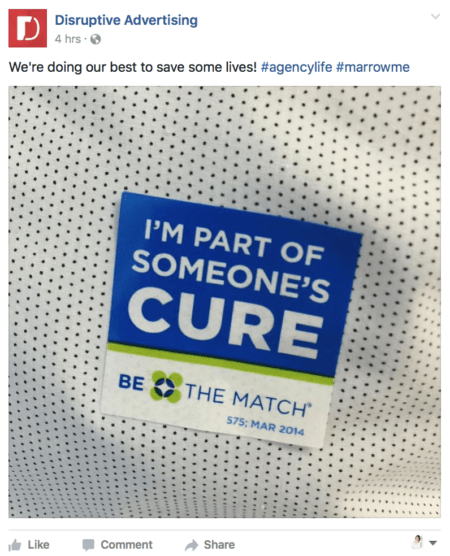
Some high-engaging content won’t perform well as an ad. The best way to evaluate this is to consider how an individual post would help you reach a specific goal.
The last big exception is social media posts that involve an influencer or thought leaders. It’s a great practice to interact with industry peers and influencers. But, you should never run an actual ad campaign that involves them without their consent, even if you paid them to create a post on social media about your product. Check your contract with them before you do. It never hurts to double check.
If you want to make the most of your influencer posts, try asking them to promote content they created about your product or offer. This gets them traffic, and increases your brand awareness for a win-win.
Legally speaking, you’ll also want to make sure that you’re never promoting content that you don’t have the rights to use—this includes images. Fortunately, there are lots of ways to get free stock photos. Facebook itself has plenty of great photos you can use for free, and you can search on sites like Unsplash or Pixabay for free images.
Conclusion
Repurposing your best social media content allows you to get the most out of your best content. These campaigns can help you connect with new members of your target audience without a lot of risk involved. Just follow the steps discussed above and you’ll be able to turn great organic social media posts into great social ads in no time at all.
By the way, if you’d like us to take a look at your organic posts and help you identify good candidates for paid ads, let us know here or in the comments. We’d love to help!
What do you think? How do you repurpose social media content? Do you ever repurpose social media content into ads? Leave us a comment and let us know what you think!





